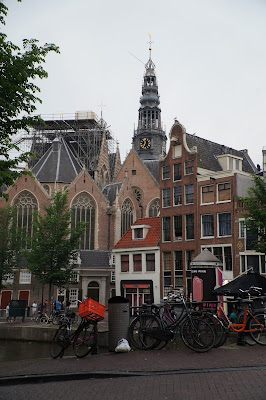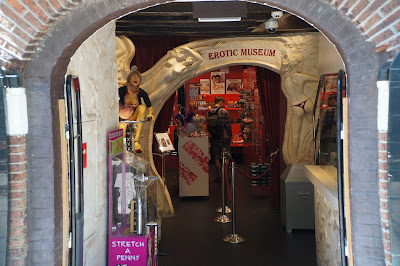Marijuana is also legal with shops selling a variety of products to get you high and paraphanelia to go with it. I was tempted to buy pot chocolate bars but knew they'd nail me at customs if I tried to bring home any souvenirs. On the weekend one can almost get a contact high just walking down the street. Otherwise beer flows freely. Sunday morning there were several young men sleeping it off on the sidewalks and I wondered if they still had their wallets.
On a more sober note, Amsterdam is loaded with canals, at least in the old section. Boats are parked all along them: rowboats, motorboats, tourist boats, even houseboats decked out with flowerpots. If one is lucky enough to catch the sun shining, the buildings cast colorful reflections on the sparkling water.I watched the progress of a couple ducks building an nest in a dingy full of water and a blue heron standing on the prow of another in the center of the red light district showing no concern at all about the party raging around him. I met a couple adding their love lock to the colorful collection already padlocked to a small bridge, a declaration of love they told me while hamming it up for my camera.
My first impression of the buildings was that they leaned but not in harmony. I thought it was age and the fact that much of old Amsterdam is built on pilings sunk into what was once a waterway. On a walking tour our guide explained it: taxes were once assessed by footage on the street so houses were built tall, narrow and deep. At the top there is a hook to haul up the furniture because of the too-narrow stairwells and some buildings were tilted to facilitate the process...and to keep the rain out. Many buildings have the same step and bell-gabled styles I saw in Belgium but a good number were far more ornate, some decorated with images of trade, heraldry and classical statues.
 |
| These figures indicated apothecaries. |





Culture? There is plenty. I got lost a few times before I found museumsplein where there are a few museum options. I chose the Van Gogh Museum where I was blown away by his skill represented in so many styles. Amsterdam seems to prefer Rembrandt, honoring him with a museum as well as a park bearing his statue and a bronze 3d version of his painting Night Watch. I am ashamed to admit its the only museum I visited in Amsterdam. Their is variety in the buskers who play accordian, classical or light jazz; not one rock 'n roller did I encounter.
 |
| Donald Duck a la Van Gogh. |
 |
| These boys were amazing. |
 |










































